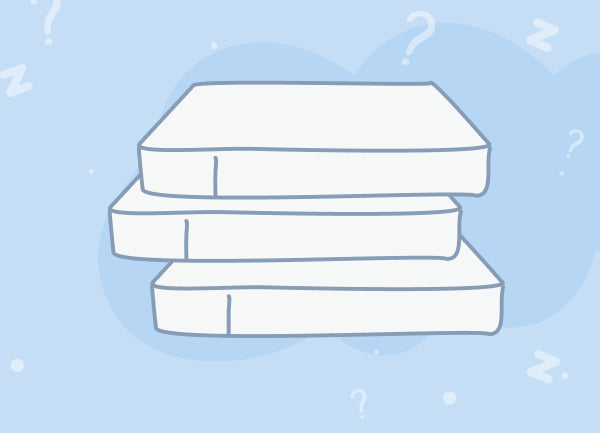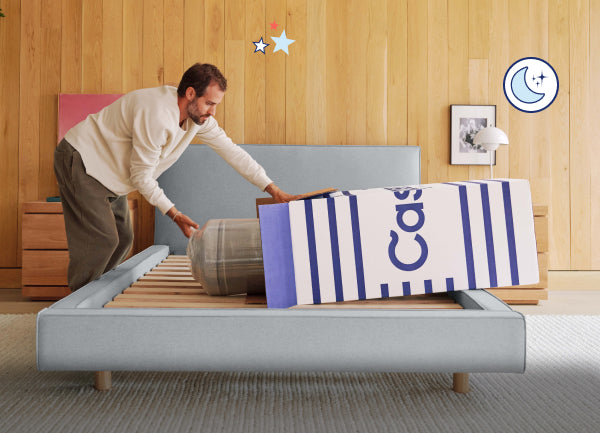Updated May 28, 2025
Down is made from the soft under feathers of ducks or geese, while down alternative is a synthetic material designed to mimic the feel of traditional down without using animal products.
The primary difference between down vs. down alternative is the filling: while down is sourced from the soft undercoat of birds, down alternative is made from a synthetic polyester material that mimics traditional down’s natural softness.
Down and down alternatives are some of the most popular filling types for pillows and duvet inserts. But which material is best for your specific needs?
While allergy-prone people might be more inclined to go with a down alternative bedding option because of its hypoallergenic properties, those looking for a lightweight, lofty feeling might prefer traditional down. Keep reading to learn the differences between down and down alternative, so you can decide which fill material type is right for you.
What Is Down?

Known for its incredible softness, down is a filling feather gathered from the undercoat of geese, ducks, and swans. Because of its lightweight nature and lofty fluff, down is a great temperature regulator for hot sleepers.
Since down comes from animals, consider whether it is ethically sourced down and certified by the Responsible Down Standard (RDS).
Who down is best for:
- People who tend to sleep hot
- People who are looking for a long-lasting investment piece
- People who love fluffy, pillowy sleeping materials
What Is Down Alternative?

Down alternative is a synthetic form of traditional down. But what is a down alternative fill made of? This innovative fill material is usually constructed with a polyester microfiber fill (not to be confused with the cheaper poly-fill) that simulates the pillowy feeling of authentic down at a fraction of the cost.
Since down alternative doesn’t use animal-sourced materials, the synthetic material is an excellent alternative for people who are allergic to down but are looking for a pillow with a lush loft.
Who down alternative is best for:
- People who are allergic to down
- People who don’t want to purchase animal-based products
- People who want a machine-washable option
- Budget-conscious shoppers
Down vs. Down Alternative: Key Areas of Difference

While down and down alternative can look and feel similar at first glance, there are some important differences that can impact your sleep experience. Let’s break down how they compare to help you choose the best option for your needs.
Fill
With down fill, you’ll want to look at the fill power to determine the quality of the down. Fill power is the amount of space one ounce of down occupies, and a higher fill power means the down has higher insulation properties.
- 400–600 fill: This fill level is great for people in warm climates who don’t have to worry about insulating themselves at night.
- 600–800 fill: This fill level is considered excellent quality and is ideal for people who live in colder weather or like to sleep in lower temperatures.
- 800+ fill: Fill of this level is ideal for people who live in freezing temperatures or need the extra warmth at night.
Down alternative filling is much more challenging to quantify since it can be made of several different synthetic materials. However, to reach comparable insulation levels, down alternative needs to be more densely filled, meaning that it is much heavier than its natural counterpart.
Best option: down
Allergies
Since down fill is made from bird feathers, it can cause allergic reactions, especially for those with goose down allergies. Additionally, down feathers may trigger other bedroom allergies because they are more prone to trapping skin cells, pet dander, and dust mites.
Down alternative fill is a great hypoallergenic alternative to traditional down. Since down alternative uses synthetic materials, it’s far less likely to collect allergens that cause bedroom allergies.
Best option: down alternative
Breathability
Down fill is known for being exceptionally soft and breathable. The structure of down creates thousands of tiny air pockets that not only trap warmth but also allow moisture vapor to escape, making down an effective and breathable insulation material.1,2,3 Additionally, because of the lighter nature of down, you’ll be able to get that light, luxurious feeling without any of the added weight that you find with faux materials. Down material is great for breathability whether you’re using a down duvet or comforter.
Since the down alternative requires more fill to attain similar insulation levels, it may be less breathable than traditional down. If you tend to sleep cool, down alternative comforters and duvets can be a great choice for keeping you warm and comfortable at night.
Best option: down
Cleaning
While down can be a bit more challenging to clean, some down items may still be machine washable. If you get a machine-washable down pillow, be sure to use a front load washer with non-chlorine bleach and a mild detergent. If you tumble dry your down, use dryer balls (or clean tennis balls) in the dryer to prevent lumps from forming. Always check the manufacturer’s care instructions first, as cleaning recommendations are highly dependent on the specific materials and construction of your bedding.
Many down duvets or comforters need to be dry cleaned for the best results. To minimize the need for extra dry cleaning, be sure to put on a duvet cover and follow the care instructions closely.
Down alternative pillows are easy to clean since they’re machine washable. To wash your pillows, just place the down alternative pillow in your machine with cool water and a mild detergent. Be sure to use dryer balls or clean tennis balls in the dryer to prevent clumps and lumps.
Many down alternative duvet inserts can be cleaned at home in a washing machine, making them an easy choice if you’re looking for low-maintenance bedding. To protect your bedding further, consider using a mattress protector.
Best option: down alternative
Durability
If you’re looking for a long-lasting investment pillow, traditional down may be your best bet. Traditional down filling is more durable than its synthetic counterpart. With daily fluffing and careful cleaning, down pillows and duvets can last for years.
Because down alternative is easier to wash at home, it can lead to more wear and tear. However, down alternative comforters, pillows, and duvets can still last for years with proper care. No matter which material pillow or duvet you choose, you’ll want to make sure it has a warranty so you can sleep well knowing that you’re covered if anything happens.
Best option: down
Cost
Because of how the materials are sourced, you’ll probably pay a bit more for down vs. down alternative.
Because down is sourced from real wildfowl, the material is naturally more expensive. Our down pillows start at $159, but you can sleep with peace of mind that your down pillow has been sourced from birds who have been treated with care.
Down alternative is a great budget-friendly alternative to down pillows. Our down alternative pillow starts at $65, so you can get the sleep of your dreams without breaking the bank.
Best option: down alternative
Feel
When it comes to feel, down offers an airy, cloud-like loft that’s hard to beat. It’s naturally soft, lightweight, and compressible, creating that classic “sink-in” comfort you expect from luxury bedding. Down alternative, while designed to mimic down, tends to be slightly denser and heavier because it requires more filling to match the same insulation.
Best option: down
Down vs. Down Alternative: How to Choose the Right Bedding for You?

The decision between down vs. down alternative ultimately comes down to your personal preference. While traditional down provides a fluffier feel, a down alternative is a great choice for those looking for a comfortable, wallet-friendly option. Here are some factors to consider as you pick between the two.
Who is down best for?
Down bedding excels at trapping warmth while remaining lightweight, making it ideal for people who tend to feel cold at night or live in areas with colder temperatures. Its superior insulation provides cozy comfort without the bulk of heavier blanket. While down is warm, it is also more breathable than many synthetic alternatives, which helps regulate body temperature and reduces the risk of overheating-especially if you choose a lighter fill or all-season weight.
It’s also a great option for those looking to invest in a high-quality bedding piece that will last for years with proper care. Whether you’re debating between different types of pillows or need a new duvet, down is the way to go if you love the feeling of sinking into something fluffy, airy, and cloud-like.
Who is down alternative best for?
As mentioned, down alternative is a smart choice for anyone with allergies or sensitivities who still craves that soft, lofty feel. It's also ideal for people who prefer not to purchase animal-based products but still want plush comfort. Plus, if you’re looking for bedding that’s easier to clean, more affordable, and machine-washable, down alternative offers all the coziness without the extra maintenance or higher price tag.
Shopping for Down vs Down Alternative: Casper's Top Picks
Whether you’re craving the luxurious loft of real down or the easy-care softness of down alternative, Casper has you covered. Explore our top picks for down and down alternative duvets and pillows to find the perfect balance of comfort, breathability, and support.
- The Down Duvet - Designed for fluffy comfort in any season.
- Down-Alt Duvet - Our soft fiberfill feels like down, but it’s actually polyester made from water bottles.
- Down Pillow - An airy, all-natural down fill for plushy comfort.
- Original Casper Pillow - A down-alternative pillow that’s supportive with a touch of fluff.
Choosing Comfort with Casper's Down and Down Alternative
Whether you prioritize breathability, easy care, or pure cloud-like comfort, both down and down alternative offer their own dreamy benefits. Choosing the right one simply comes down to your sleep style and what feels best for you.
Ready for some great sleep? Try out our down or down alternative duvets and pillows for the sweet comfort that dreams are made of. Whether you’re wondering how to choose a pillow filling or deciding on your next duvet, Casper has the resources and the products to support your needs.
Sources:
- REI. Down vs Synthetic Material | REI Expert Advice. https://www.rei.com/learn/expert-advice/down-vs-synthetic.html
- Outdoor Research. Down vs. Synthetic Insulation: Outdoor Research. https://www.outdoorresearch.com/blogs/stories/down-vs-synthetic-whats-the-difference-between-down-and-synthetic-insulati
- Wooded River, Inc. Filling: Poly Down Alternative vs. Traditional Down - Wooded River, Inc. https://woodedriver.com/filling-poly-down-alternative-vs-traditional-down/











